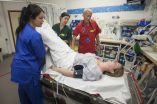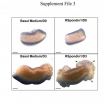(Press-News.org) A simple, safe and cost-free modification to a physical technique used to treat patients in the emergency department with an abnormally fast heart rhythm could improve its effectiveness by more than a quarter, according to a study published in The Lancet today (25 August 2015).
An abnormally fast heart rhythm, also called supraventricular tachycardia, can be distressing for patients and many come to emergency departments for treatment. Symptoms can include chest pain, light-headedness, dizziness and breathlessness. Episodes can last from a few seconds or, in extreme cases, for days.
A safe and internationally recommended first time emergency treatment is a physical treatment called the Valsalva manoeuvre. This is done by attempting to forcibly exhale or strain while keeping the nose and mouth closed. This physical strain, changes the rate and volume of blood returning to the heart and causes a reflex slowing of the heart rate which can return the heart rhythm to a normal rate.
While recommended, the standard Valsalva manoeuvre has a low success rate of between five and 20 per cent, which often necessitates the use of other treatments such as a drug called adenosine, which is given by injection. This has significant side effects with many patients reporting a sense of doom or the feeling that they are going to die as the drug is being injected.
A research team, led by the Royal Devon and Exeter NHS Foundation Trust, have undertaken a study across ten NHS emergency departments involving more than 400 patients, to investigate whether a modification to posture in the Valsalva manoeuvre would improve its performance in treating patients with an abnormally fast heart rate. This is the first randomised controlled trial to assess the effect of modifying posture in the technique.
The team were supported by the Peninsula Clinical Trials Unit at Plymouth University and the NIHR Clinical Research Network for the South West Peninsula.
They found that by repositioning patients immediately after the strain (laying flat with legs lifted by staff to increase blood flow back to the heart), the Valsalva manoeuvre was much more successful in returning the heart rhythm to a normal rate. In the study, only 17.5 per cent of patients using the traditional posture experienced a return to normal heart rate, while for those using the modified posture the success rate was significantly greater, at 43.5 per cent.
The findings of the study are significant, because they identify a simple, safe, comfortable-for-the-patient and cost-free method to improve the success of the Valsalva manoeuvre.
This is important because it is a more effective treatment than the standard technique, can potentially reduce the number of patients who require drugs with unpleasant side effects or other emergency treatments, and, because there is no cost, could be introduced worldwide - including areas with limited health care resources.
The study was led by Andrew Appelboam, Consultant in Emergency Medicine and the Royal Devon and Exeter NHS Foundation Trust, UK. He said:
"While supraventricular tachycardia is rarely life threatening, it can be extremely distressing for patients. We thought that the Valsalva manoeuvre had potential to be yet more effective as a treatment option and our study has borne this out. What it means is that more patients can benefit from it without the need for further treatments with significant side effects. It also means that, because the postural modification is cost-free with no identified disadvantages, it could be easily adopted worldwide."
INFORMATION:
THELANCET-D-15-055555R1
Title: Postural modification to the standard Valsalva manoeuvre for the emergency treatment of supraventricular tachycardias (REVERT): a randomised control trial
This news release is available in German. Trillions of bacteria populate the human gut - which makes them more common than any other cells in our body. The composition of this bacterial population is very variable and influenced by our diet. Diseases, but also antibiotic treatments can induce significant shifts in this equilibrium. If entire bacterial groups suddenly multiply heavily, critical situations occur. They damage the intestinal tissue and cause inflammations. How such shifts are triggered largely remained a mystery. Physiologists from the University of Zurich ...
This news release is available in German.
Root bacteria are known to form symbiotic relationships with plants by improving the plants' supply of nutrients. Yet as scientists at the Max Planck Institute for Chemical Ecology in Jena, Germany, found recently, the bacteria actually play a much more profound role. During field experiments in Utah, in the western USA, researchers discovered that the right mixture of soil microbiota directly influences the survival of Nicotiana attenuata, a species of wild tobacco. Plants that had been unable to establish a protective ...
University of Manchester scientists have bridged a gap between two separate pieces of small intestine kept alive outside the body, in an advance which could have implications for surgery in human adults and babies.
It is not currently possible to study the intestine in embryos when inside the body, which holds back advances in treatment for conditions causing damage in infants. However, new techniques used by the researchers in this study have allowed organs to be kept alive and grown on supports which allow the absorption of nutrients.
A video is available here
or ...
In an era where popular culture is increasingly recognized for its impact on lay understanding of health and medicine, few scholars have looked at television's powerful role in the creation of patient expectations, especially regarding pregnancy and birth.
As part of a larger research project funded by a National Science Foundation Dissertation Improvement Grant, Danielle Bessett, University of Cincinnati assistant professor of sociology in the McMicken College of Arts and Sciences examined how women understand their television viewing practices regarding pregnancy and ...
A team of researchers at the U.S. Department of Energy (DOE)'s Lawrence Berkeley National Laboratory (Berkeley Lab) developing a bioinorganic hybrid approach to artificial photosynthesis have achieved another milestone. Having generated quite a buzz with their hybrid system of semiconducting nanowires and bacteria that used electrons to synthesize carbon dioxide into acetate, the team has now developed a hybrid system that produces renewable molecular hydrogen and uses it to synthesize carbon dioxide into methane, the primary constituent of natural gas.
"This study represents ...
Waterford, Ireland, August 24, 2015 - Ongoing European Research Council-funded research at Waterford Institute of Technology's (WIT) Macular Pigment Research Group (MPRG) is investigating the potential link between cognitive function and levels of a vital eye pigment linked to diet. The study suggests that measuring macular pigment offers potential as a biomarker of cognitive health. The results of this study are highlighted to a global audience through the prestigious international medical journal, the Journal of Alzheimer's Disease.
The Waterford clinical trial research, ...
Tahiti is a popular tourist destination, but one unwanted visitor has decided to make its home there: the brown widow spider (Latrodectus geometricus). A paper published in the Journal of Medical Entomology has reported the discovery of the spider for the first time on Tahiti and also on four of the Cook Islands.
The brown widow is a known invasive species. It has been found in South America, Central America, North America, the Caribbean islands, and a host of Pacific islands. It was first found in French Polynesia in 2006, when it was discovered on the island of Moorea. ...
WASHINGTON (Aug. 25, 2015)--In the most comprehensive study to date, researchers at the George Washington University have identified a potential link between microbes (viruses, bacteria and fungi) in the throat and schizophrenia. This link may offer a way to identify causes and develop treatments of the disease and lead to new diagnostic tests.
"The oropharynx of schizophrenics seems to harbor different proportions of oral bacteria than healthy individuals," said Eduardo Castro-Nallar, a Ph.D. candidate at GW's Computational Biology Institute (CBI) and lead author of ...
Tampa, Fla. (Aug. 25, 2015) - Fresh water--connecting and sustaining all aspects of life on Earth, including food and energy--is in great danger. Moreover, scientists are worried not only about fresh water; they worry that we are not worried enough about fresh water, especially in light of growing concern over recent events, such as the prolonged California drought. The current Special Issue Section of Technology and Innovation - Journal of the National Academy of Inventors has a special section devoted to fresh water and the challenges it faces from us and from the changing ...
Tampa, Fla. (Aug. 25, 2015) - Wasting fresh water is a real concern. A recent study conducted with homeowners in central Florida found that, on average, 64 percent of the drinking water used by homes went to irrigation. In the summer months, this percentage increased to 88 percent. As the population increases, conservation of fresh water becomes increasingly important.
The Special Issue Section of the current Technology and Innovation - Journal of the National Academy of Inventors focuses on challenges to fresh water from environmental changes and from the human population.
Florida ...



